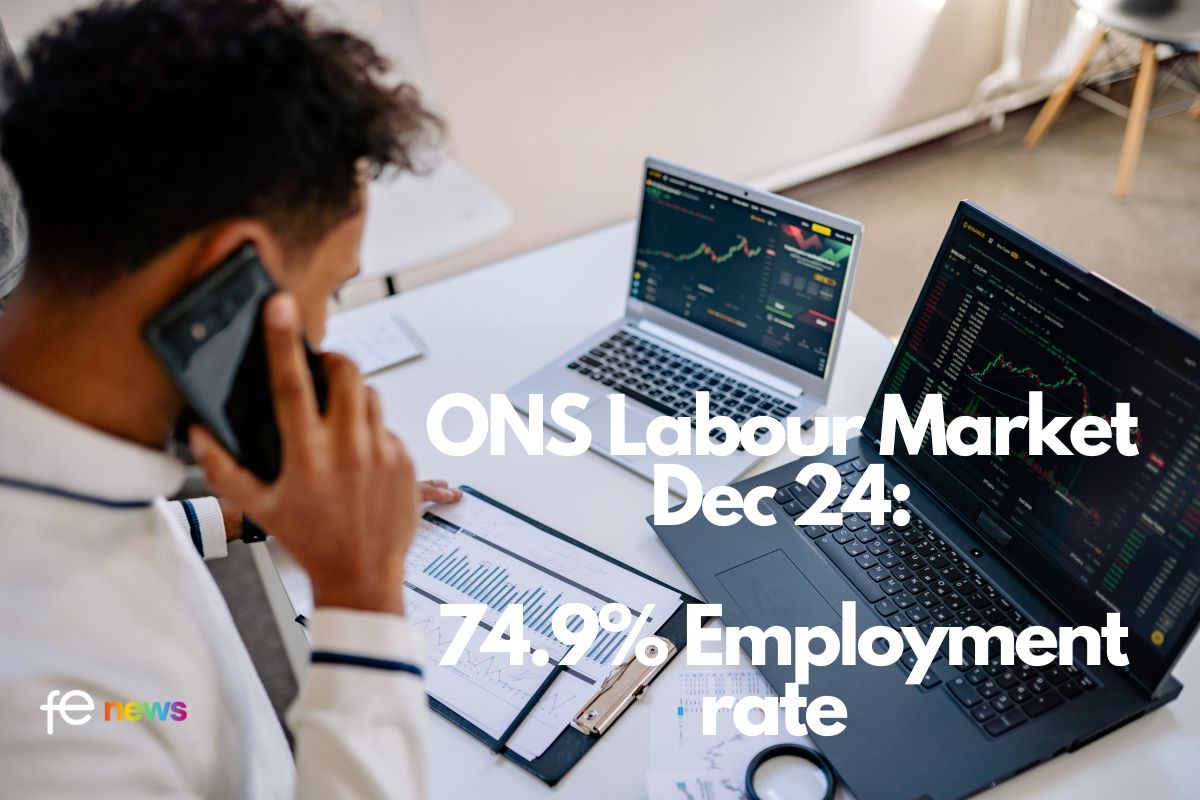ONS Labour Market Figures for Dec 24: 74.9% Employment rate and 137,000 fewer vacancies than a year ago

The latest ONS Labour Market figures have been released today.
The UK employment rate for people aged 16 to 64 years was estimated at 74.9% in August to October 2024. This is largely unchanged on a year ago, but up in the latest quarter.
The UK unemployment rate for people aged 16 years and over was estimated at 4.3% in August to October 2024. This is above estimates of a year ago, and up in the latest quarter.
The UK economic inactivity rate for people aged 16 to 64 years was estimated at 21.7% in August to October 2024. This is below estimates of a year ago, and down in the latest quarter.
The estimated number of workforce jobs was 36.8 million in September 2024, an increase of 73,000 (0.2%) from June 2024. There were increases in both employee jobs and self-employment.
The UK Claimant Count for November 2024 increased both on the month and on the year, to 1.769 million.
The estimated number of vacancies in the UK decreased by 31,000 on the quarter to 818,000 in September to November 2024. Vacancies decreased on the quarter for the 29th consecutive period but are still above pre-coronavirus (COVID-19) pandemic levels.
Annual growth in employees’ average earnings for both regular (excluding bonuses) and total earnings (including bonuses) in Great Britain was 5.2% in August to October 2024.
Annual growth in real terms, adjusted for inflation using the Consumer Prices Index including owner occupiers’ housing costs (CPIH), was 2.2% for both regular and total pay in August to October 2024.
There were an estimated 42,000 working days lost because of labour disputes across the UK in October 2024.
Overview:
- Vacancies decreased to 818,000. There are 137,000 fewer vacancies than a year ago (Sept-Nov 2023) and vacancies have been falling consistently for two and half years
- Youth unemployment rate remains high at 12.7%
- Economic Inactivity from long-term sickness also remains high at 2.8 million
- Regular pay growth has risen to 5.2% on the year. The UK is in a 33-month run of above 4% pay growth – the longest run of sustained pay growth since records began in 2001.
- However, wages are just £23 a week higher in real terms than they were at the start of the global financial crisis in August 2008.
- The Employment rate is at 74.9%, up on the quarter but largely unchanged on a year ago. Unemployment is up on the quarter and on a year ago at 4.3%. However, official ONS Labour Force Survey data is continuing to face reliability issues.
- Economic inactivity due to long-term sickness is up on the year at 2.8 million. It has been above 2.7 million for 17 consecutive months since Apr-Jun 2023.
Work and Pensions Secretary, Liz Kendall MP said:
“Today’s figures are a stark reminder of the work that needs to be done.
“To get Britain growing again, we need to get Britain working again – so people have good jobs which pay decent wages and offer the chance to progress.
“Through our Get Britain Working Plan we will do just that – transforming Jobcentres, making sure every young person is earning or learning and properly joining up work, health and skills support to drive up employment and drive down poverty in every corner of our country.
“And from April, someone working full time on the minimum wage will be £1,400 better off, meaning more money in people’s pockets, delivering on the plan for change to improve living standards and make people better off.”
Sector Reaction to the ONS Labour Market Figures:
Comment from Ben Harrison, Director of the Work Foundation at Lancaster University.
“Today’s figures raise key questions for policymakers as while wage growth has risen, vacancies have fallen to near pre-pandemic levels and economic inactivity remains a substantial challenge.
“Annual nominal pay growth has risen to 5.2% on the year. The UK is on a 33-month run of above 4% wage growth, which is the strongest period of wage growth for almost a quarter of a century.
“This sustained wage growth may raise questions for Bank of England rate setters as they contemplate reducing interest rates this side of Christmas. But the reality is that many workers are barely feeling better off. The impact of a decade of stagnating wages and a cost of living crisis that has hit living standards means that average wages are just £23 a week higher in real terms than they were at the start of the global financial crisis in August 2008. This underscores the scale of the challenge Government faces in fulfilling its ‘mission’ to raise living standards in every part of the UK.
“As employers report their intent to cut jobs in the aftermath of the recent Budget, the latest data suggests the number of vacancies has continued to decline – falling by 137,000 on the year. 2024 has seen the end of an era of high vacancies following the pandemic. It appears hiring confidence is likely to remain subdued in early 2025, with business confidence dipping following employer tax increases and the economy struggling to grow.
“The slowdown in hiring could pose a challenge to the Government’s plans to grow the economy by getting Britain working. A near record 2.8 million are economically inactive due to long-term sickness, with 659,000 wanting to work. While proposed reforms to employment support and Jobcentre’s are welcome, our recent longitudinal research found that almost half of employees who leave work due to ill health, do so in the first 12 months of becoming sick. It is therefore vital that the Government focusses on prevention and early intervention in 2025 to support ill workers to stay in employment.”
The Recruitment and Employment Confederation (REC) Chief Executive Neil Carberry said:
“Today’s labour market statistics show that there is still much to do to address business concerns about the direction of travel. Across the year, firms have been communicating confidence about their own firms but worries about the outlook. These firms want to drive growth, but for now are feeling the impacts of the increase in Employers National Insurance and are worried about the undercooked Employment Rights Bill. Today’s figures show a 1.5% increase in the number of temporary employees – a confirmation again of how much businesses and workers need flexibility especially when the economy is uncertain.
“NHS employment rising is only good if it is addressing waiting lists – Government risks damaging progress by failing to plan for workforce properly, including a sustainable strategy for agency. From keeping the NHS on its feet to helping people find their first steps in work, government needs to embrace the many ways in which people work today if it is to be successful. Backing temporary workers matters to our economy – but most of all to the temps themselves.”
Responding to the latest ONS figures, Stephen Evans, chief executive at Learning and Work Institute (L&W), said:
“On most measures the labour market looks flat, with employment little changed and vacancies down. Employment growth seems to have driven most by rises in health and social care, with the latest HMRC data showing falls in sectors like hospitality. This suggests an underlying weakness in the economy. Progress toward the Government’s 80% employment rate target depends on getting the economy going and providing more help for people outside the labour market to find jobs.”











Responses